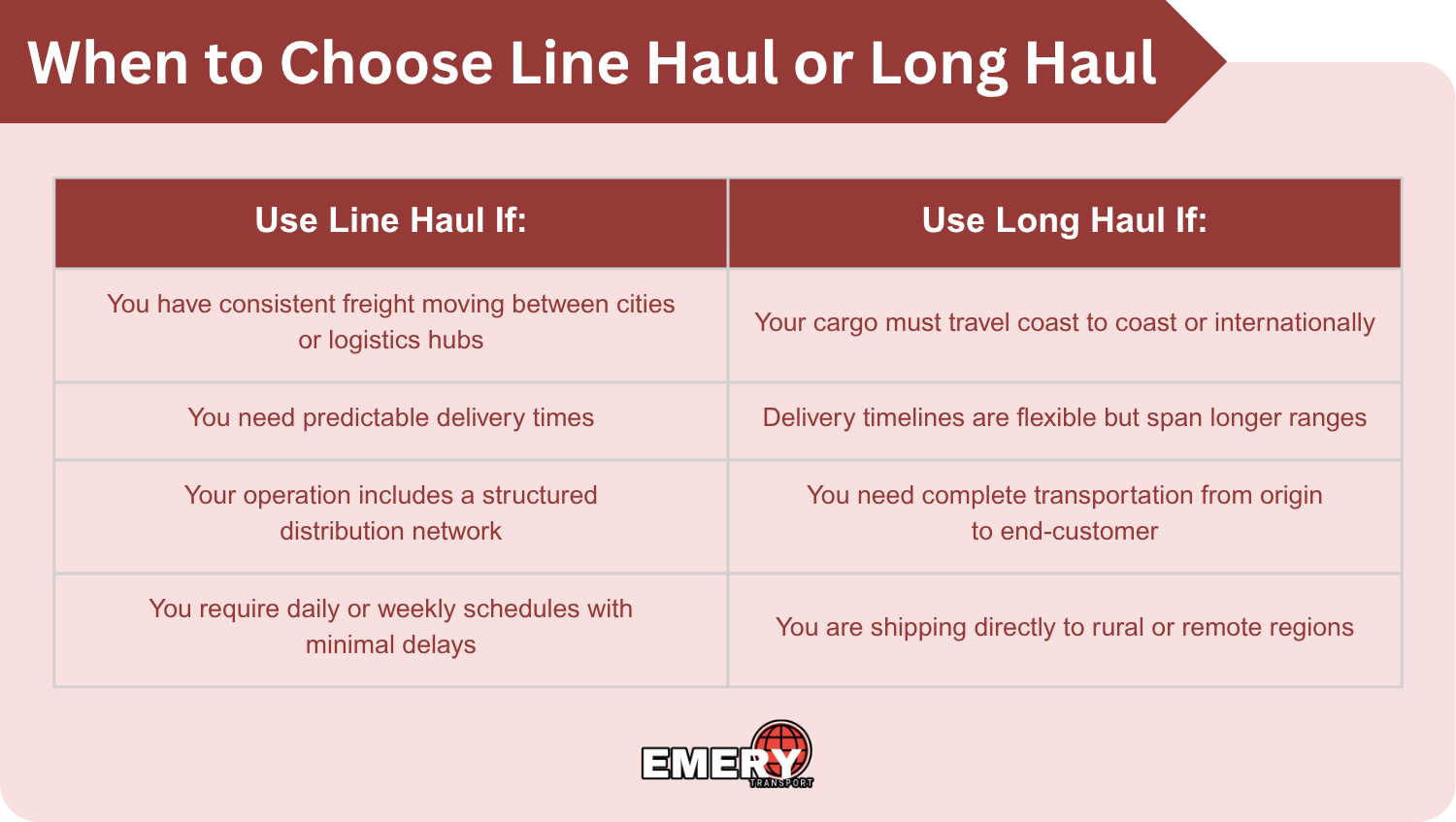In the logistics world, terminology often overlaps; however, understanding the distinction between line haul and long-haul transportation is crucial for efficient supply chain planning. Emery Transport’s linehaul transportation services provide a reliable framework that helps businesses move goods across short and long distances with precision and care.
Choosing the appropriate transport service, whether line haul or long haul, is crucial for manufacturers, distributors, and retailers, as it significantly affects delivery speed, costs, and customer satisfaction.
Understanding the Core Concepts

To fully grasp the difference between line haul and long haul, it’s important to look at what each term means and how they function within freight logistics.
Line Haul: Consistency Across Defined Routes
Line haul transportation refers to the movement of freight between designated terminals or distribution centers. This typically includes regular, predictable routes connecting cities or key logistics hubs. These are usually shorter in range than long-haul trips but form the backbone of scheduled freight systems.
With Emery Transport, linehaul services ensure timely and efficient transfers between regional locations, forming a crucial part of the national and cross-border delivery network. They are ideal for businesses that operate in structured supply chains and require reliable mid-range transportation.
Long Haul: Flexibility Over Extended Distances
In contrast, long-haul transport covers greater distances—often over 400 kilometres—and involves deliveries that may cross provincial or national borders. These routes may not be fixed or repetitive and are often adapted based on client needs.
Emery Transport manages long haul operations with specialized equipment and experienced drivers to guarantee safety, fuel efficiency, and on-time performance—even on remote or cross-country journeys.
Key Differences Between Line Haul and Long Haul
While both involve moving cargo from one place to another, several factors set them apart:
- Distance: Line haul typically covers mid-range distances between hubs, while long haul spans thousands of kilometres.
- Route Regularity: Line haul follows predefined schedules and routes. Long haul is more dynamic and can vary based on destination.
- Driver Operations: Line haul often involves regional drivers who return to base daily or after short trips. Long haul drivers may be on the road for days or weeks.
- Fleet Requirements: Long haul requires robust trucks equipped for endurance and comfort, while line haul may use lighter, more agile vehicles.
- Delivery Type: Line haul typically serves business-to-business (B2B) needs between warehouses, while long haul often includes direct-to-distributor or end-customer shipping.
What is the difference between line haul and long haul?
While both terms refer to the movement of goods over distances, line haul typically involves regular, fixed routes between terminals or hubs. In contrast, long haul may include more flexible or irregular routes and longer distances, often across multiple states or provinces.

Emery Transport’s Approach to Both Services
At Emery Transport, both line-haul and long-haul services are designed to serve clients with efficiency, transparency, and reliability. Whether your goods are travelling 100 or 1,000 kilometres, the logistics team works to develop tailored routing strategies and safety-first plans that align with your delivery objectives.
Their use of fleet monitoring technology, regulatory compliance, and cargo-specific solutions ensures that your shipments are handled with care, no matter the distance.
Industries That Rely on Line and Long Haul
Retail & E-Commerce
Retailers rely on line-haul services to stock regional distribution centers and long-haul routes, enabling them to fulfill cross-country or U.S.-to-Canada deliveries.
Food & Beverage
From fresh produce to frozen goods, Emery Transport’s temperature-controlled long haul fleet ensures product quality across large distances, while linehaul helps with rapid turnover between processing and distribution.
Construction & Manufacturing
Machinery, steel, and raw materials often require robust long haul capabilities, while line haul manages consistent inventory between job sites and warehouses.
Mid-Journey Processing and Hub Transfers
In many cases, line haul and long haul are interconnected. A product may start its journey with long haul transport, reach a main hub, and then transfer to a line haul route to reach a regional distribution center.
What is arrived at linehaul
This term usually indicates that the shipment has reached a central hub or processing center as part of its scheduled linehaul route, awaiting further transfer or delivery.
This handoff between transportation stages is where Emery Transport shines, ensuring smooth transitions and on-time performance throughout the supply chain.
Environmental and Cost Considerations
Emery Transport also prioritizes fuel efficiency and environmental responsibility in both types of services. Through intelligent route optimization and eco-conscious vehicle upgrades, Emery helps clients reduce carbon impact while keeping shipping costs competitive.
Line haul, in particular, enables greater load consolidation, resulting in fewer trips, reduced fuel usage, and more cost-effective logistics.
Choosing the Right Model for Your Business
Understanding the difference between line haul and long haul is more than a logistics lesson—it’s about choosing the best route for your business goals. Emery Transport delivers both options with reliability, transparency, and customized service to meet the needs of our clients.
If your cargo needs predictable, mid-range movement between hubs, line haul is the answer. For long-distance, cross-border, or full-route coverage, long haul offers the flexibility and reach your operation demands.
Who is the most reliable delivery service in Montreal?
Without a doubt, Emery Transport stands out as a trusted name for both linehaul and long haul services across the Montreal region and beyond, offering unmatched performance, dependability, and client satisfaction.


